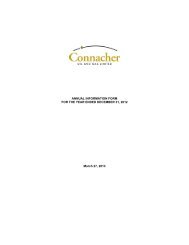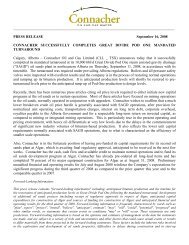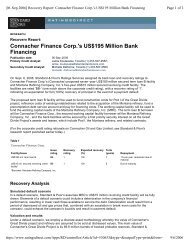ANNUAL REPORT 2011 - Connacher Oil and Gas
ANNUAL REPORT 2011 - Connacher Oil and Gas
ANNUAL REPORT 2011 - Connacher Oil and Gas
You also want an ePaper? Increase the reach of your titles
YUMPU automatically turns print PDFs into web optimized ePapers that Google loves.
AR <strong>2011</strong><br />
PG 80<br />
26. Commitments<br />
Capital expenditure commitments<br />
As at December 31<br />
<strong>2011</strong> 2010<br />
(Canadian dollar in thous<strong>and</strong>s)<br />
Commitments relating to the acquisition of property, plant <strong>and</strong> equipment $ – $ 1,566<br />
Service <strong>and</strong> maintenance commitments<br />
The company is also contractually committed under certain contracts for the service <strong>and</strong> maintenance of facilities <strong>and</strong> equipment. The following table<br />
provides the details of these commitments:<br />
As at December 31<br />
<strong>2011</strong> 2010<br />
(Canadian dollar in thous<strong>and</strong>s)<br />
No later than 1 year $ 8,487 $ 4,104<br />
Later than 1 year but no later than 5 years 20,584 12,171<br />
Later than 5 years 16,800 38,702<br />
Total commitments $ 45,871 $ 54,977<br />
The primary service <strong>and</strong> maintenance commitment of the company included above relates to power infrastructure costs of $31.8 million as at<br />
December 31, <strong>2011</strong>.<br />
27. First TIME ADOPTION of IFRS<br />
As described in note 2, these are the company’s first consolidated financial statements prepared in accordance with IFRS. As a result, these<br />
consolidated financial statements have been prepared in accordance with IFRS 1, “First–time Adoption of International Financial Reporting St<strong>and</strong>ards”.<br />
IFRS 1 requires the presentation of comparative information as at the January 1, 2010 (the “transition date”) <strong>and</strong> subsequent comparative periods<br />
using the consistent <strong>and</strong> retrospective application of IFRS accounting policies. However, to assist with the transition, the provisions of IFRS 1 allow<br />
for certain m<strong>and</strong>atory exceptions <strong>and</strong> optional exemptions from the requirement of retrospective application of accounting policies <strong>and</strong> st<strong>and</strong>ards on<br />
first–time adoption of IFRS. Accordingly, these consolidated financial statements were prepared using the accounting policies stated in note 3 of the<br />
consolidated financial statements <strong>and</strong> were retrospectively <strong>and</strong> consistently applied except where specific IFRS 1 m<strong>and</strong>atory exceptions <strong>and</strong> optional<br />
exemptions required or permitted an alternative treatment upon transition to IFRS for first–time adopters. The significant m<strong>and</strong>atory exceptions <strong>and</strong><br />
optional exemptions applied under IFRS 1 in preparing these consolidated financial statements are set out below:<br />
Deemed cost election for petroleum <strong>and</strong> natural gas properties<br />
Under previous GAAP, the company followed the “full cost” method of accounting for petroleum <strong>and</strong> natural gas activities under which all costs directly<br />
associated with the acquisition of, the exploration for, <strong>and</strong> the development of petroleum <strong>and</strong> natural gas reserves were capitalized on a country–<br />
by–country cost centre basis. The company had one cost centre, Canada, for the upstream segment. Costs accumulated within this one cost centre<br />
were depleted using the unit–of–production method based on proved reserves determined using estimated future prices <strong>and</strong> costs. Upon transition<br />
to IFRS, the company was required to adopt new accounting policies for upstream activities, including the segregation of exploration <strong>and</strong> evaluation<br />
costs <strong>and</strong> petroleum <strong>and</strong> natural gas properties. Under IFRS, exploration <strong>and</strong> evaluation costs are those expenditures for which technical feasibility<br />
<strong>and</strong> commercial viability has not yet been determined, are presented separately on the balance sheet as exploration <strong>and</strong> evaluation assets <strong>and</strong> may<br />
or may not be amortized based on the company’s accounting policy. Petroleum <strong>and</strong> natural gas properties include those expenditures where technical<br />
feasibility <strong>and</strong> commercial viability has been determined, are presented as a part of property, plant <strong>and</strong> equipment on the balance sheet <strong>and</strong> are<br />
depleted <strong>and</strong> depreciated on a segregated basis based on the company’s accounting policy. The company adopted the IFRS 1 exemption whereby the<br />
company deemed its January 1, 2010 IFRS upstream asset costs to be equal to its previous GAAP historical upstream property, plant <strong>and</strong> equipment<br />
net book value. Accordingly, exploration <strong>and</strong> evaluation costs were deemed equal to the unproved properties balance <strong>and</strong> the petroleum <strong>and</strong> natural<br />
gas properties costs were deemed equal to the remaining upstream full cost pool balance. The petroleum <strong>and</strong> natural gas property costs were<br />
allocated for depletion, depreciation <strong>and</strong> impairment testing purposes on a pro rata basis using proved reserves values at the transition date.<br />
Leases<br />
The company elected not to reassess whether an arrangement contained a lease under IFRIC 4, “Determining whether an Arrangement contains a<br />
Lease”, for contracts that were assessed under previous GAAP.<br />
Business combinations<br />
IFRS 3, “Business Combinations” was not applied to business combinations that occurred before the transition date.<br />
Borrowing costs<br />
Borrowing costs directly attributable to the acquisition or construction of qualifying assets were not retrospectively restated prior to the transition date.












